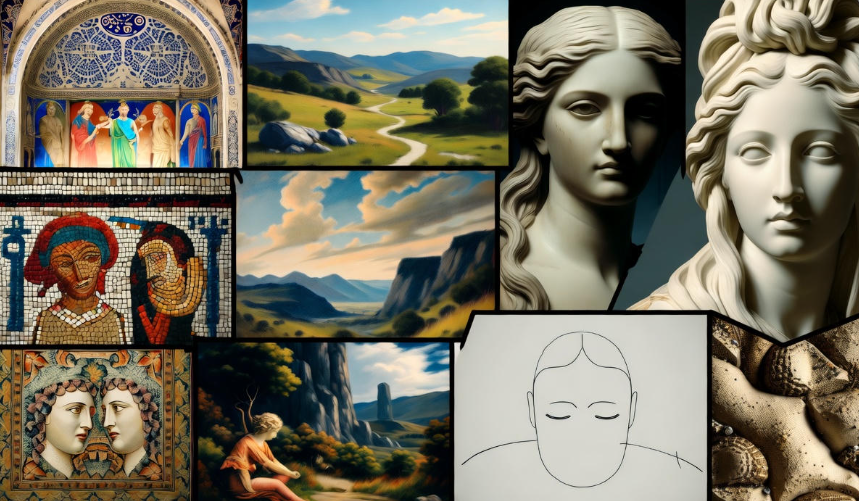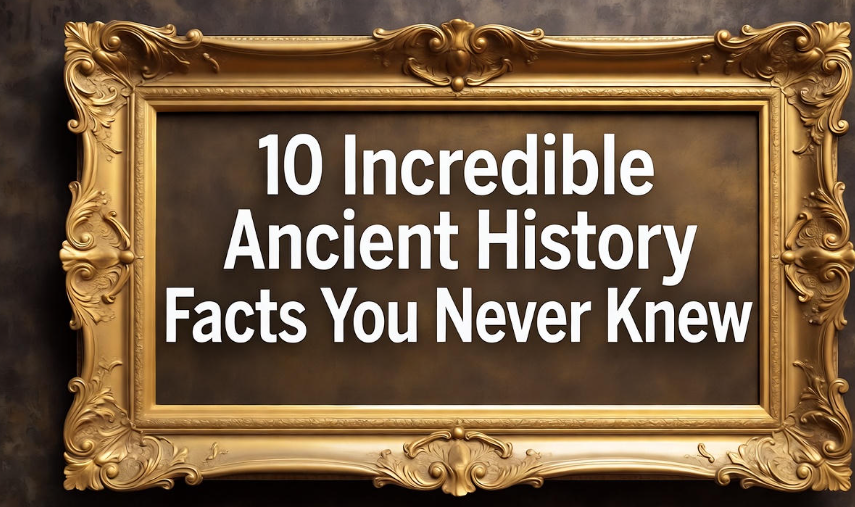Art has always been humanity’s way of speaking without words. Long before books or movies existed, people used stone, clay, and paint to tell stories — stories about love, fear, gods, wars, and dreams. Ancient artworks are more than just old paintings or carvings; they are messages from people who lived thousands of years ago, still whispering to us today.
So, let’s travel back in time and explore ten fascinating ancient artworks that carry powerful stories — stories that remind us of who we are and how we got here.
1. The Cave Paintings of Lascaux, France
Imagine stepping into a cave and seeing giant paintings of bulls, horses, and deer — drawn by people who lived over 17,000 years ago. That’s the magic of Lascaux Cave in France. These paintings aren’t just random doodles. Many researchers believe they tell stories of hunting, rituals, and survival.
The artists used mineral pigments and animal fat lamps to light up the cave. Some say the paintings were created to bring luck before a hunt. Others believe they show early humans’ spiritual connection to nature.
It’s amazing, right? Even without words, you can feel their courage and fear — standing in the dark, painting their lives on the stone walls.
2. The Standard of Ur, Mesopotamia ⚔️
This little box from ancient Mesopotamia (around 2600 BCE) may look simple, but it’s like a mini history movie carved in stone. Found in the Royal Cemetery of Ur, it has two sides: one shows peace, and the other shows war.
On the “war” side, soldiers march and fight; on the “peace” side, people celebrate and feast. Historians believe it tells the story of how kings maintained both power and prosperity — using war to win peace.
Here’s a small breakdown:
| Side | Meaning | Key Imagery |
|---|---|---|
| War | Strength, battle victories | Soldiers, chariots, prisoners |
| Peace | Prosperity after success | Music, banquets, trade |
It’s a reminder that human life has always swung between conflict and calm.
3. The Bust of Nefertiti, Egypt
If there’s one face that still mesmerizes the world after 3,000 years, it’s Queen Nefertiti. Her painted limestone bust was discovered in 1912 in Amarna, Egypt. Her beauty isn’t the only reason people admire her — it’s the story she carries.
Nefertiti wasn’t just a queen; she was a revolutionary. Alongside her husband Akhenaten, she changed Egypt’s religion, promoting the worship of one god — Aten, the sun disk. That was a huge shift in a culture filled with many gods.
Her calm face and graceful neck in the sculpture reflect power, peace, and divine authority. It’s art and history blended into perfection.
4. The Terracotta Army, China
In 1974, farmers in China made one of the most stunning discoveries ever — an underground army made of clay! Over 8,000 life-sized soldiers, each with different facial expressions, were buried to guard Emperor Qin Shi Huang in the afterlife.
Every warrior tells a story — of loyalty, of craftsmanship, of a civilization that believed in life after death. Creating them took years of effort and incredible skill. Some scholars say the army reflects the emperor’s obsession with immortality and control, even beyond death.
It’s haunting yet deeply human — the desire to be remembered forever.
5. The Parthenon Sculptures, Greece ️
The Parthenon, built around 447 BCE in Athens, was not just a temple — it was a statement of pride, faith, and perfection. The marble sculptures, known as the Elgin Marbles, depict gods, warriors, and everyday people in breathtaking motion.
They tell the story of Athens’ power and devotion to the goddess Athena, their protector. Each figure was carefully carved to show balance and harmony — the core ideas of Greek culture.
Even now, these sculptures spark debates about beauty, ownership, and cultural heritage. They’re not just art; they’re pieces of identity.
6. The Great Wave off Kanagawa, Japan
Although not as ancient as cave paintings, The Great Wave off Kanagawa (created in the 1830s by Hokusai) carries the spirit of timeless storytelling. The artwork shows a huge wave towering over boats, with Mount Fuji calm in the distance.
It’s more than just a beautiful print — it’s a symbol of Japan’s relationship with nature. The wave represents power, unpredictability, and resilience. Many see it as a reflection of human struggle against natural forces.
Even centuries later, the wave still speaks to us — that sometimes, the most powerful forces can’t be fought, only faced.

7. The Lion Hunt Reliefs, Assyria
The Lion Hunt Reliefs from the palace of King Ashurbanipal (7th century BCE) are pure storytelling in stone. The carvings show the king battling lions — not just for sport, but as a symbol of bravery and royal power.
The level of detail is incredible. You can almost feel the tension, the arrows flying, the lions roaring. These scenes were meant to show the king as a protector of his people, fighting chaos (the lion) to bring order.
It’s one of those artworks where you can sense both beauty and brutality — the perfect balance of storytelling through art.
8. The Mask of Tutankhamun, Egypt
The golden mask of King Tutankhamun is one of the most famous treasures from ancient Egypt. When archaeologists discovered his tomb in 1922, the world was stunned. The mask, made of solid gold and inlaid with precious stones, wasn’t just for decoration.
It told a story — a young pharaoh’s journey into the afterlife. The mask was believed to help Tut’s spirit recognize his body and live forever among the gods. Every symbol, from the cobra and vulture on his forehead to the calm expression, represents protection and divine rebirth.
It’s art with purpose — beauty designed to bridge life and eternity.
9. The Bayeux Tapestry, France/England
This one’s not painted or sculpted — it’s stitched. The Bayeux Tapestry (11th century) tells the story of the Norman conquest of England in 1066.
It’s nearly 70 meters long and shows everything — from preparations for battle to the famous Battle of Hastings. The best part? It was created like a comic strip, long before comics existed!
Through threads and fabric, it tells a political drama filled with betrayal, bravery, and destiny. It’s proof that art doesn’t need fancy materials to tell a powerful story — just hands that weave history.
10. The Venus of Willendorf, Austria
Last but not least, meet the Venus of Willendorf — a tiny limestone statue around 30,000 years old. She has exaggerated curves and no face, yet she’s one of the most meaningful artworks in human history.
Historians believe she represents fertility, motherhood, and the idea of life itself. She may have been used as a charm for good luck or safe childbirth.
What’s beautiful about her is simplicity. She’s small, but she carries the weight of human beginnings — the story of how we saw beauty and survival intertwined.
-
Read more like this: 7 Times Innovation Changed History Forever
What These Artworks Teach Us
Ancient art wasn’t just about decoration. Every line, curve, and color carried a story — about life, faith, death, and power. These artworks show that humans have always wanted to express themselves, to remember, to connect.
Even though centuries have passed, these creations still move us. They remind us that storytelling isn’t only through words — sometimes, it’s through silence carved in stone or color brushed on a wall.
Quick Summary Table ️
| Artwork | Origin | Approx. Age | Story/Theme |
|---|---|---|---|
| Lascaux Cave Paintings | France | 17,000 years | Life, hunting, rituals |
| Standard of Ur | Mesopotamia | 2600 BCE | War and peace |
| Bust of Nefertiti | Egypt | 1345 BCE | Beauty and power |
| Terracotta Army | China | 210 BCE | Eternal protection |
| Parthenon Sculptures | Greece | 447 BCE | Faith, perfection |
| Great Wave off Kanagawa | Japan | 1830s | Nature and resilience |
| Lion Hunt Reliefs | Assyria | 7th century BCE | Courage, order |
| Mask of Tutankhamun | Egypt | 1323 BCE | Immortality |
| Bayeux Tapestry | France/England | 11th century | Conquest, destiny |
| Venus of Willendorf | Austria | 30,000 years | Fertility, life |
FAQs ♀️
Q1: Why do ancient artworks still matter today?
Because they show us how people lived, what they valued, and how they expressed emotions long before language and technology evolved. They’re like emotional time capsules.
Q2: How do we know what these artworks mean?
Historians, archaeologists, and art experts study their symbols, materials, and contexts — sometimes even comparing them with ancient texts or rituals.
Q3: Are all ancient artworks religious?
Not all, but many were connected to religion or spirituality since ancient people often linked art with gods, life, and death.
Q4: What’s the oldest known artwork in the world?
The cave paintings of Chauvet and Lascaux in France are among the oldest, dating back over 30,000 years.
Q5: Can we visit these artworks today?
Some yes, like replicas of the Lascaux caves or the British Museum’s Mesopotamian pieces. Others, like the Terracotta Army or Parthenon, are major tourist sites.
Final Thought
When you look at ancient art, you’re not just seeing paint, stone, or clay — you’re seeing humanity itself. Every brushstroke, every carving, every symbol was made by someone who wanted to leave a mark, to be remembered.




